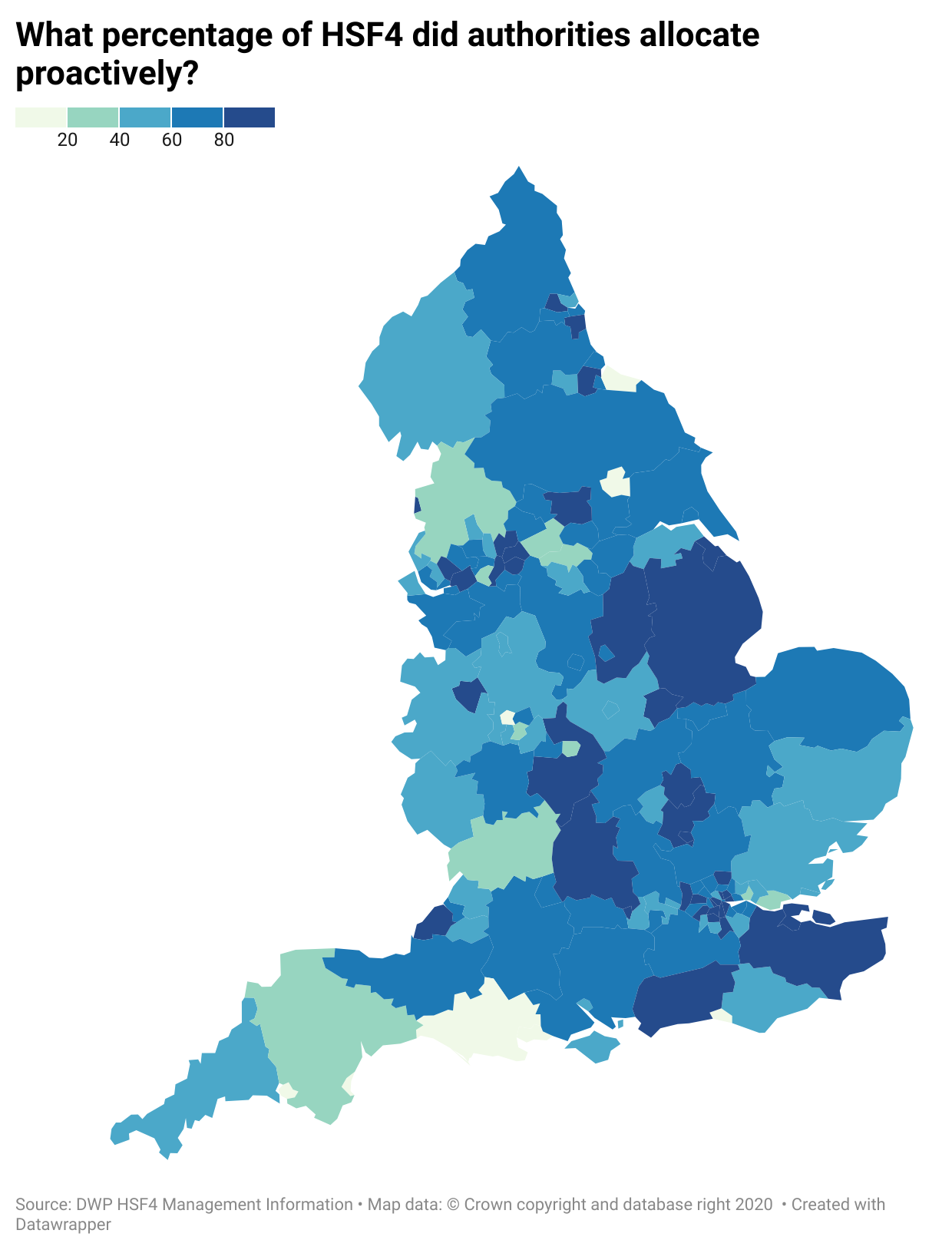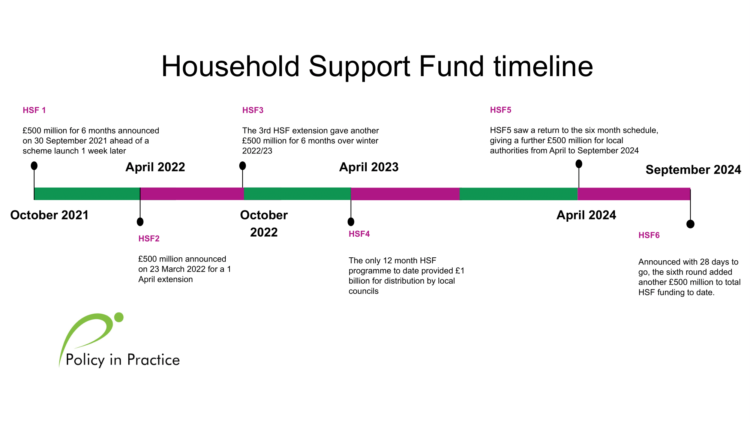Household Support Fund 6 and the Winter Fuel Payment

Household Support Fund 6 has now been confirmed, giving local authorities more funding for low income households this winter. This blog looks at previous Household Support Fund spending patterns and asks how we can combine policy support and data analysis to use the HSF to support people now missing out on the Winter Fuel Payment.
Tuesday 1 October 2024 saw the beginning of the sixth round of the Household Support Fund (HSF). Extended by the new government four weeks before the end of HSF5, the new round runs from October 2024 to April 2025. It adds another £500 million to the £3 billion already spent by local authorities to support low income households in their communities since the fund was launched three years ago.
With 84% of English local authorities expecting demand for local welfare support to rise over the coming winter, the announcement will have come as a major relief to local government, third party support organisations, and members of the public alike.
Three years on from its creation, now is the time to take stock of the increasingly central role that the HSF, an essentially short term measure, has come to play within the local welfare assistance landscape.
Local government support with and without the Household Support Fund
Initially intended as a stopgap measure to allow local support for residents during the worst of the cost of living crisis, HSF has by now become indispensable to local authorities. Surveyed before the latest round of funding was confirmed, two out of three authorities in England stated that their local welfare support would decrease without another round of HSF.
Remarkably, one in five councils said that they had no additional local welfare schemes beyond what was funded via the HSF, meaning without an extension there would be no discretionary local welfare support for residents.
Local welfare assistance schemes are incredibly powerful, being well placed to help individuals at the moment of greatest need. Research by Policy in Practice for London Councils and the Greater London Authority has demonstrated the ability of local support to make a real difference, even with relatively low cost interventions.
Putting local welfare support on a secure footing is the smart thing to do.
Local authorities agree while the central government’s announcement of HSF6 stated that it was also ‘exploring options around how best to provide sustainable support to vulnerable households in the longer term’. The outlook for the future of longer term crisis support is hopeful. In the meantime, however, the focus remains on maximising the impact of HSF6.
Household Support Fund management information tells us everything and nothing
Analysis of HSF spending to date shows a postcode lottery of support, as local authorities make different and difficult decisions about how to target funding. One common pattern seen across England is an overwhelming focus on the young, with two out of every three pounds spent under the first four rounds of HSF going to households with children.
HSF4 spending patterns show children were the focus of the majority of local schemes
Management information from HSF4, published this week, demonstrates that the type, amount and availability of funding does not depend on need; it depends on geography.
The breakdown of HSF3 fund distribution told us very little in terms of trends with wild variations in policy design resulting in an almost chaotic map of distribution.
However, reports on HSF4, the only HSF programme to run for 12 months, have failed to give greater insight into local welfare assistance other than to show us there is no pattern. Frustrating? Yes. Symptomatic of the variation of need? Possibly.
While never wanting to burden frontline delivery with onerous management information returns, the broad brush approach taken by HSF at a national level demonstrates the need for more granular information and more data control.
HSF4 expenditure on children ranged from 14% in North Yorkshire to 96% in Warwickshire. For four local authorities, no awards were recorded as being made to pensioners, and another six authorities recorded no awards for people with disabilities.
By comparison, North Yorkshire allocated 43% of its funding to pensioners, and Nottinghamshire County Council spent 44% of its funding on people with disabilities.
HSF4 reports also tell us that Bristol, a unitary authority with 205,000 residential properties and around 480,000 residents, made more than 800,000 HSF4 awards. Similarly, Nottingham City Council made more than 670,000 HSF4 awards, despite having only 330,000 residents.
Figures like this could mean both councils have distributed an award to each resident more than once, or to a small group of residents many times over.
Or, it could be that data collection for HSF is fundamentally flawed to the extent that analysis is difficult to say the least and that tapping into other datasets, specifically benefits administrative data could provide the insight we truly need to design effective local welfare assistance.
If analysis is difficult for us looking in from the outside, for the new government planning local welfare assistance going forward, it is an impossible task and a waste of three years of opportunity to collect meaningful, relevant, and contemporary data on the extreme need faced by low income communities.
Councils are also divided when it comes to proactive versus reactive allocation of HSF funding. On average, almost £2 in every £3 spent as part of HSF4 went on proactive support for residents, but some authorities chose to focus entirely on reactive application-based support while others proactively targeted all of their support.
We know that proactive awards generally can reduce the likelihood of stigma preventing those in need from getting the support they require, while also minimising administration costs. Making HSF support more targeted will be central to making HSF6 go further.

How the smart use of data can help authorities maximise the impact of HSF6
Getting HSF6 right is crucial.
The government’s decision to restrict eligibility for the Winter Fuel Payment to older people in receipt of Pension Credit has created a new need to support the one million households who will now miss out on help for their energy bills.
Pensioners, who received just £1 in every £10 spent under HSF3 and HSF4, will now be a priority group for councils as they think about allocating HSF6.
Policy in Practice is working with local authorities to identify pensioners who fall just above the threshold for Pension Credit, to allow for precise targeting of HSF6 funds to impacted residents. Innovative use of administrative data can allow councils to proactively target funding to those groups who need it most.
Since the first round of HSF, councils have been using Policy in Practice’s LIFT platform to identify residents who would benefit most from support, removing the need for any applications and assessments.
LIFT is used by one in five local authorities who use their administrative data to get insights into their local low income households, including over forty different household characteristics.
Policy in Practice was shortlisted for an LGC Award in 2022 for our work helping local authorities to allocate £18.5 million worth of Household Support Fund using LIFT. Over the last three years LIFT has consistently helped councils to spend more of their HSF money on households in need, and less on administration.
Next steps
- Find out how much Pension Credit is unclaimed in your area and how many pensioners have income just above the Pension Credit threshold here
- Learn how LIFT is helping one in five local authorities to run Pension Credit take up campaigns. Details here
- Join our free webinars to hear our policy experts and guest speakers explore policy challenges and solutions. Details here






